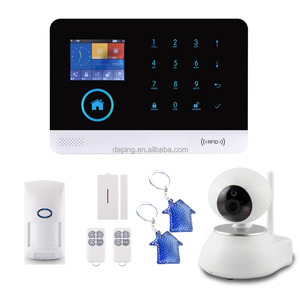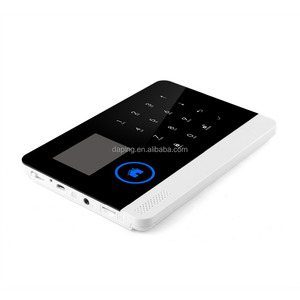
All categories
Featured selections
Trade Assurance
Buyer Central
Help Center
Get the app
Become a supplier

(3500 products available)














































Radio frequency identification systems identify and track tagged objects using electromagnetic fields. These systems enhance security with an RFID door alarm to strengthen building security. The door generates an electromagnetic field, and when a tag passes through the field, it triggers an alarm. Kinds of RFID door alarms include the following.
Single-zone RFID door alarms use a single tag to identify a single door. If a person tries to access that door without authorization, the system will notify them. The RFID tag can be a key fob or a card that a person will show at the door. Single-zone systems are straightforward and easy to use. They are commonly used where adequate control is required over access to a specific area. Regions with sensitive information or costly equipment typically require this system.
The multi-zone RFID alarm system monitors multiple zones concurrently. Zones use readers, and every zone uses its set of tags. This system provides better coverage to areas where multi-door access is critical. For example, these systems are suitable for large businesses or buildings requiring intricate access control. Also, they are ideal for multi-level security systems.
This alarm detects unauthorized movement through a door and is portable. They enable security personnel to carry them around. Personnel uses this system to scan tags and detect door security breaches. Many portable RFID alarms have built-in GSM communication. Hence, they can send real-time notifications to the user’s mobile. This feature is very important for speedy response to the breach.
Integrated RFID alarms work with a broader security framework. They integrate with CCTV cameras, intruder alarms, and building automation systems. This integration enables a more comprehensive security outlook. In these systems, an RFID tag holder triggers the alarm on a disgruntled employee by passing through a security door.
When choosing an RFID door alarm, certain features are imperative to consider. These features include sensitivity levels, alarm types, installation processes, and operating ranges. Below are the important features of an alarm system.
Multi-tag capability is significant where one door has many users. It allows the system to recognize several tags simultaneously. This feature enables seamless traffic flow in busy areas. The system uses it to differentiate authorized personnel from unauthorized ones. Hence, there will be no logging jam at the entrance.
Systems with real-time notifications enhance security by alerting personnel immediately after a breach. Many RFID door alarms have push notification features. This ensures that users receive instant alerts via mobile or other connected devices. This capability is vital in security operations where quick response is crucial. For example, an alarm triggering can allow security personnel to respond appropriately to a possible threat.
Another important feature is how easily the RFID door alarm can be installed. Many systems currently available in the market have simple, do-it-yourself installations. These systems run on battery, easing their installation since they do not require much effort. Easy installation systems are suitable for businesses with many doors. This makes the process less labor-intensive and more efficient.
RFID door alarms are important in commercial enterprises. They enhance security while allowing easy access to authorized individuals in various enterprises. Below are some of the commercial uses of these alarms.
Hotels use RFID door alarms to improve guest room and restricted area access. Guests receive RFID cards to access their rooms. This system eliminates the need for traditional keys. Hence, it reduces the risk of losing keys and improving security. Additionally, staff accesses warehouses, manager offices, and other restricted areas using these alarms. The system automatically logs each access for security monitoring and auditing.
Hospitals and healthcare centers have sensitive areas like drug storage and patient records. They use RFID door alarms to control and monitor access to these zones. Staff members use RFID tags to enter these areas, which ensures only authorized personnel can access sensitive areas. The system then sends real-time alerts when there is unauthorized access. This improves incident response and lowers the risk of data breaches and thefts.
Colleges and schools use RFID door alarms to secure entrances, laboratories, and libraries. They issue RFID tags to students, staff, and visitors. The system records everyone’s entry and exit, which then improves campus safety. It restricts access to sensitive areas while tracking attendance in courses taken by students. Schools love these systems because they integrate with emergency protocols. This affords the institution greater control over security procedures in emergencies.
Factories and warehouses have large areas with high security. They need effective access control solutions. The RFID door alarm provides seamless access in these industrial settings. Workers and authorized personnel use RFID tags to enter work areas and access control systems. The system improves workplace security by preventing unauthorized access to hazardous areas or valuable equipment.
Retail outlets use these alarms to safeguard stock rooms, cash offices, and other restricted areas. Stores issue RFID tags to authorized workers with access to important operating locations. This action lowers theft and fraud risk. The systems can scan customer traffic as they leave the store. This allows quick verification and better checkout procedures.
Choosing the right RFID door alarm for clients or one’s business requires careful consideration. These considerations include system application, scalability, user-friendliness, maintenance, and budget. Below are some important pointers to consider when choosing these alarms.
Consider the size of the retail store when making the choice. For small stores, single-zone systems work best. They are easy to install and manage. Large enterprises require multi-zone RFID readers. They help cover all high-traffic areas. Complex spaces need portable RFID alarms for thorough monitoring.
Real-time alert systems are essential for clients in industries that need immediate breach notifications. Industries like manufacturing and logistics benefit from RFID alarms with real-time alerts.
Pick an RFID door alarm with a simple installation process for the client. Go for systems that are easy to maintain. The last thing the client wants is to deal with complicated technical issues. Also, consider whether the system is wired or wireless. Wireless systems run on batteries. They often require fewer resources for their installation and maintenance.
Considering integrating the RFID door alarm with other systems is important. Alarms work great with existing surveillance and building automation systems. Clients may already have these systems in place. Select an alarm that integrates seamlessly.
This system ensures that operability, system testing, and prompt maintenance work together to secure the RFIF doors effectively.
Selecting the right alarm system depends on business size, installation, integration, maintenance, and operating costs.
Wireless systems that have waterproof and dustproof features are suitable for long life. Alarms made with durable materials are long-lasting.
Only if the environmental and operating conditions are ideal will an RFID system work effectively in an outdoor area.
The system should undergo periodic testing and checks. This will ensure that the vital hardware and software components are functional.